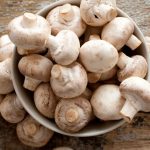 Before its current name was adopted by English in the fifteenth century, the mushroom was known either as a funge, a word deriving from the Latin fungus, or as a toadstool, a word of fanciful English origin. When the word mushroom was finally adopted from French in the fifteenth century, these three words were used more or less interchangeably. By the eighteenth century, however, most people were distinguishing them: mushroom referred to an edible umbrella-shaped fungus; toadstool referred to a poisonous umbrellashaped fungus; andfunge—or rather fungus, which had been readopted from Latin in the early sixteenth century—referred generally to all mushrooms, toadstools, and mould. It was also not until the eighteenth century that mushroom acquired its current spelling: when originally adopted from French, the word was spelt mousseron, but the influence of the unrelated but familiar words mush and room caused the form of the word to change. The French themselves, incidentally, abandoned the name mousseron in favour of the current champignon, a word that derives from the Latin campus, meaning field. Further back in its history, mushroom—or rather mousseron—was formed by the French from mousse, meaning moss, because mushrooms commonly grow out of that velvety plant. Later on, mousse was also bestowed, by the French themselves, on a creamy dish whose frothiness resembles the spongy texture of moss; English borrowed the name of this dish in the late nineteenth century when mousses became popular.
Before its current name was adopted by English in the fifteenth century, the mushroom was known either as a funge, a word deriving from the Latin fungus, or as a toadstool, a word of fanciful English origin. When the word mushroom was finally adopted from French in the fifteenth century, these three words were used more or less interchangeably. By the eighteenth century, however, most people were distinguishing them: mushroom referred to an edible umbrella-shaped fungus; toadstool referred to a poisonous umbrellashaped fungus; andfunge—or rather fungus, which had been readopted from Latin in the early sixteenth century—referred generally to all mushrooms, toadstools, and mould. It was also not until the eighteenth century that mushroom acquired its current spelling: when originally adopted from French, the word was spelt mousseron, but the influence of the unrelated but familiar words mush and room caused the form of the word to change. The French themselves, incidentally, abandoned the name mousseron in favour of the current champignon, a word that derives from the Latin campus, meaning field. Further back in its history, mushroom—or rather mousseron—was formed by the French from mousse, meaning moss, because mushrooms commonly grow out of that velvety plant. Later on, mousse was also bestowed, by the French themselves, on a creamy dish whose frothiness resembles the spongy texture of moss; English borrowed the name of this dish in the late nineteenth century when mousses became popular.
Strictly, as used in this book, the fruit body of a fleshy fungus with gills; also a much less precise general term for any fruit body of a fungus.
The aerial fruiting (spore-producing) body of various fungi. Edible mushrooms include the field and cultivated mushrooms (Agaricus campestris and A. bisporus), the chanterelle (Cantherellus cibarius), and the parasol (Lepiota procera). However, great care must be taken in identifying edible fungi. Many species are poisonous, especially the death cap and panther cap.
Umbrella shaped fungus belonging to the class Basidiomycetes. Mushrooms grow on decaying vegetable matter and are generally found in woods and dark, damp places. Some of the poisonous varieties include Amanita species and toadstools.
